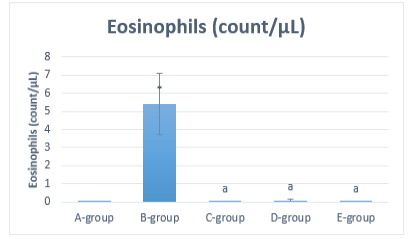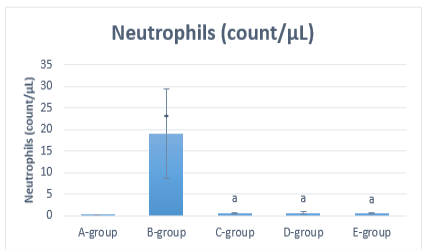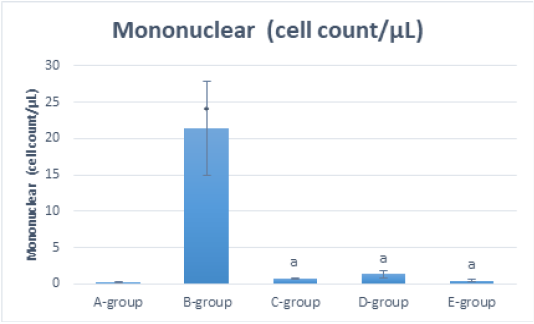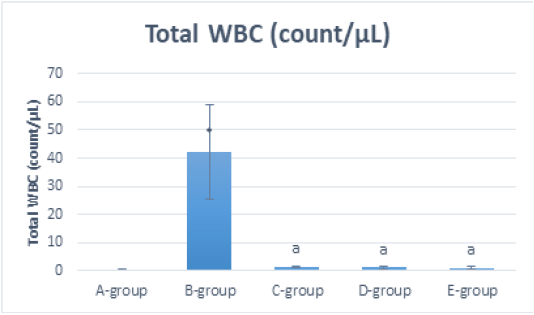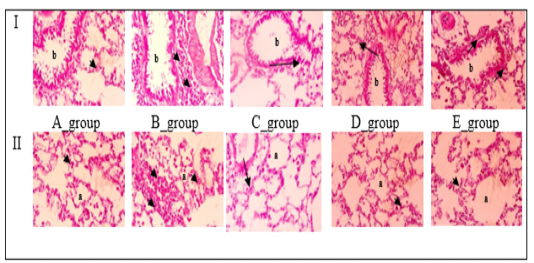An Investigation of Anti-inflammatory Effects of Famotidine in Rats by Evaluating Inflammatory Cells and Lung Histopathology An Airway Model
An Investigation of Anti-inflammatory Effects of Famotidine in Rats by Evaluating Inflammatory Cells and Lung Histopathology An Airway Model
Wasan Ali Hasan1*, Manal Abdulkhaliq Ibrahim2
The effect of famotidine on the eosinophils count in the BALF of airway-sensitized rats. OVA-sensitization resulted in an increase in eosinophils count in the BALF, whereas treatment with famotidine reduced these counts. A_group, negative control; B_group, positive control (sensitized); C_group, prednisolone; D_group, famotidine; E_group, prednisolone and famotidine; *= denoting statistical significance (P<0.05) in comparison to A_group; a= denoting statistical significance (P<0.05) in comparison to B_group.
The effect of famotidine on the neutrophils count in the BALF of airway-sensitized rats. OVA-sensitization resulted in an increased neutrophil count in the BALF of rats, whereas famotidine treatment reduced this expression significantly. A_group, negative control; B_group, positive control (sensitized); C_group, prednisolone; D_group, famotidine; E_group, prednisolone and famotidine; *= denoting statistical significance (P<0.05) in comparison to A_group; a= denoting statistical significance (P<0.05) in comparison to B_group.
The effect of famotidine on the mononuclear cell count in the BALF of airway-sensitized rats. OVA-sensitization was associated with a significant elevation in mononuclear cell count present in the BALF, whereas treatment with famotidine led to their significant reduction. A_group, negative control; B_group, positive control (sensitized); C_group, prednisolone; D_group, famotidine; E_group, prednisolone and famotidine; *= denoting statistical significance (P<0.05) in comparison to A_group; a= denoting statistical significance (P<0.05) in comparison to B_group.
The effect of famotidine on total WBC count in the BALF of airway-sensitized rats. After OVA sensitization, there was a general increase in the number of inflammatory cells in the BALF. However, treatment with famotidine resulted in a significant reduction in the WBC count. A_group, negative control; B_group, positive control (sensitized); C_group, prednisolone; D_group, famotidine; E_group, prednisolone and famotidine; *= denoting statistical significance (P<0.05) in comparison to A_group; a= denoting statistical significance (P<0.05) in comparison to B_group.
The effect of famotidine on the lung tissue histopathology. The process of OVA-sensitization resulted in a noticeable increase in the accumulation of leukocytes in lung tissue. However, in rats treated with famotidine, this accumulation was reduced, highlighting the anti-inflammatory effect of famotidine. Lung tissue photos were taken by light microscope, X-40, H&E stain. The arrows point to inflammatory cells; b, bronchioles; a, alveoli; A_group, negative control; B_group, positive control; C_group, prednisolone; D_group, famotidine; E_group, prednisolone and famotidine.





